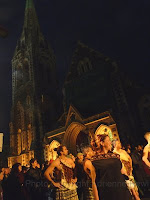
It can be said that Kapa haka dates back to pre-European times where it developed from all traditional forms of Maori pastimes; haka, mau rakau (Maori weaponry), poi (tiny ball attached to rope or string) and moteatea (traditional Maori songs). The significance of these everyday activitites were influential to the development of kapa haka. A kapa haka performance involves choral singing, dance and movements associated in the hand-to-hand combat practiced by Maori in precolonial times, presented in a synchronisation of action, timing, posture, footwork and sound. The genre evolved out of a combination of European and Maori musical principles.
 The work of a kapa haka consists of the performance of a suite of songs and dances spanning several types of Maori music and dance, strung together into a coherent whole. Music and dance types that normally appear are waiata tira (warm-up song), whakaeke (entrance song), waiata-a-ringa (action song), haka (challenge), pou or moteatea (old-style singing), poi (co-ordinated swinging of balls attached to cords), and whakawatea (closing song). They may also include titi torea (synchronised manipulation of thin sticks). In a full performance, which can last up to 40 minutes, each music or dance type may appear more than once.
The work of a kapa haka consists of the performance of a suite of songs and dances spanning several types of Maori music and dance, strung together into a coherent whole. Music and dance types that normally appear are waiata tira (warm-up song), whakaeke (entrance song), waiata-a-ringa (action song), haka (challenge), pou or moteatea (old-style singing), poi (co-ordinated swinging of balls attached to cords), and whakawatea (closing song). They may also include titi torea (synchronised manipulation of thin sticks). In a full performance, which can last up to 40 minutes, each music or dance type may appear more than once.Music for kapa haka is primarily vocal. All song types, with the notable exceptions of moteatea and haka, are structured around European-style harmony, frequently with guitar accompaniment. Spurts of haka-style declamation are woven into the songs, as are dance movements, facial expressions and other bodily and aural signals unique to Maori. Song poetry is completely in Maori and new material is continually being composed.










0 comments:
Post a Comment